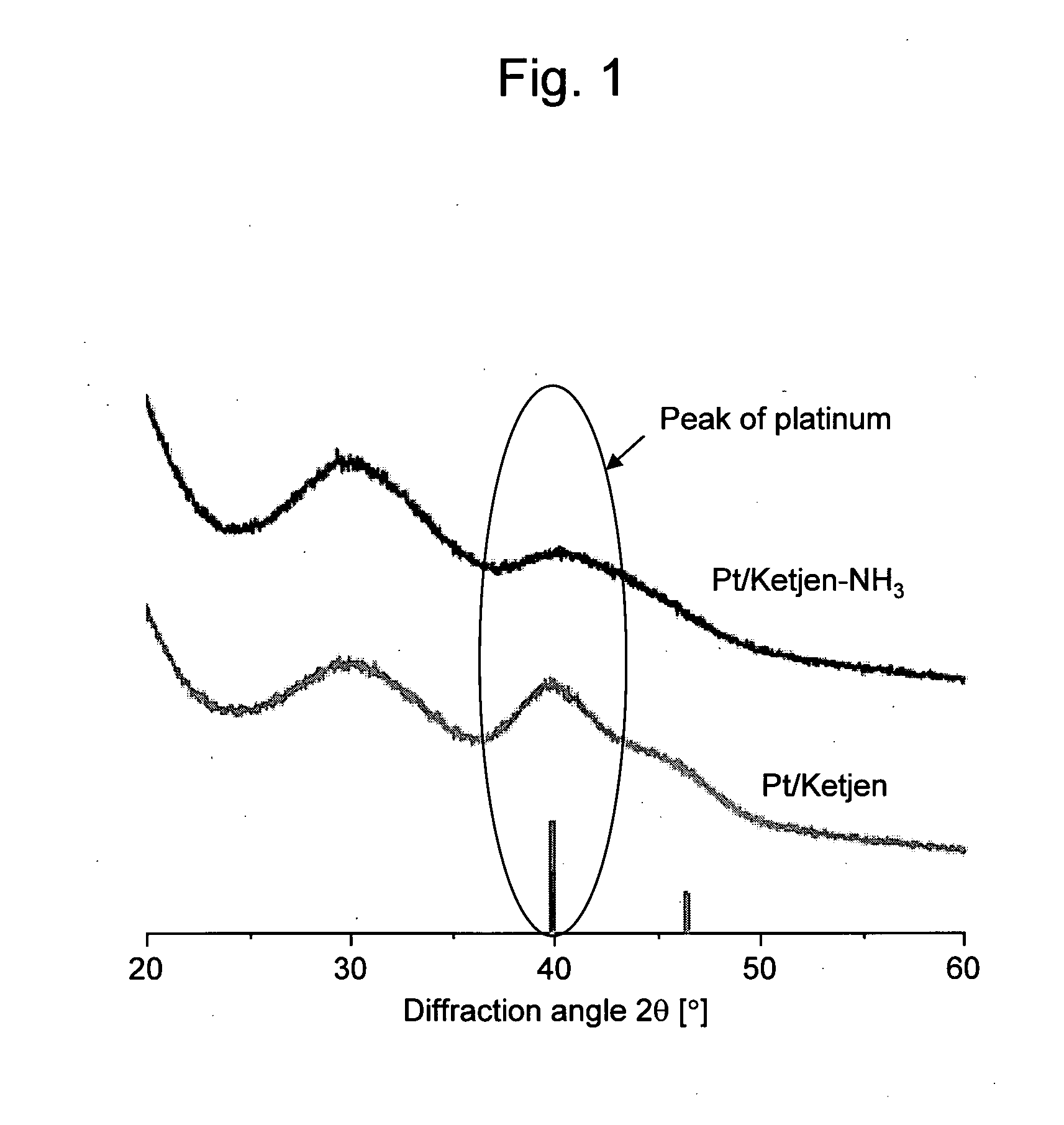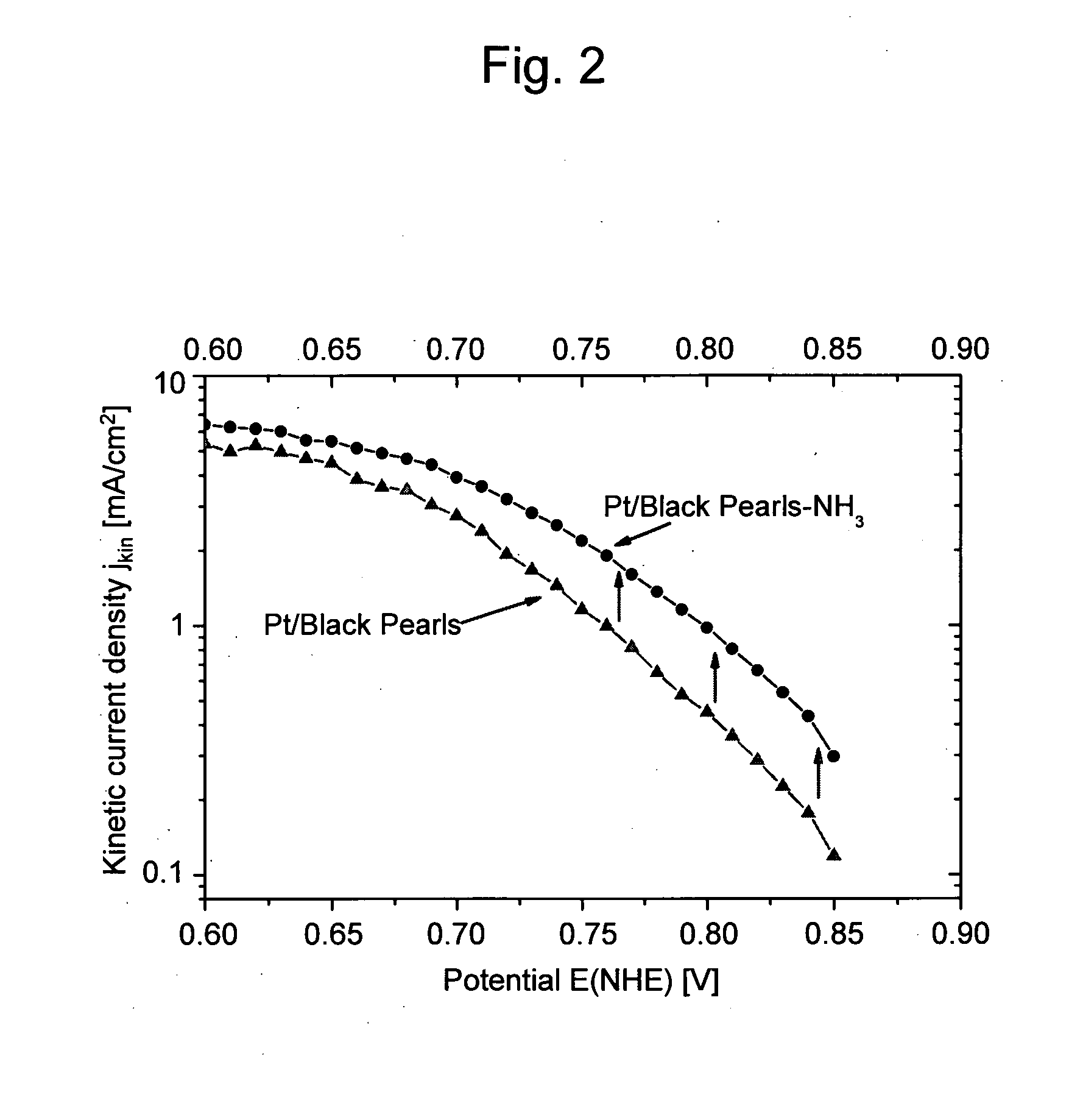Electrode catalyst for fuel cell
a fuel cell and electrode catalyst technology, applied in the field of electrode catalysts, can solve the problems of reduced cell voltage, insufficient catalytic activity, and increased particle size of sintering particles
- Summary
- Abstract
- Description
- Claims
- Application Information
AI Technical Summary
Benefits of technology
Problems solved by technology
Method used
Image
Examples
example 1
(Ammonia Treatment Step)
[0060]Ketjen EC® (Ketjen Black International Company) (specific surface area: 800 m2 / g) was used as supporting carbon powder. First, 0.5 g of the carbon powder was put in a quartz boat, and then the carbon powder was placed in a horizontal heat treatment furnace. The temperature was elevated to 800° C. at a temperature elevation rate of 800° C. / hr, and nitrogen gas was introduced into the furnace at a flow rate of 0.2 l / hr at the same time. After the temperature in the furnace reached 800° C., ammonia (NH3) gas was added to the nitrogen gas with a flow rate of 0.2 l / hr so that a NH3 / N2 ratio of 50% is obtained. The carbon powder was held at 800° C. for 30 minutes in the ammonia gas atmosphere so that the carbon powder was treated with ammonia. After the treatment was completed, the introduced gas was switched again to pure nitrogen gas, which was introduced into the furnace at a flow rate of 0.2 l / hr to cool the carbon powder to room temperature.
(Platinum Sal...
example 2
(Ammonia Treatment Step)
[0062]Black Pearls® (Cabot Corporation) (specific surface area: 1500 m2 / g) was used as supporting carbon powder. First, 0.5 g of the carbon powder was put in a quartz boat, and then the carbon powder was placed in a horizontal heat treatment furnace. The temperature was elevated to 800° C. at a temperature elevation rate of 800° C. / hr, and nitrogen gas was introduced into the furnace at a flow rate of 0.2 l / hr at the same time. After the temperature in the furnace reached 800° C., ammonia (NH3) gas was added to the nitrogen gas with a flow rate of 0.2 l / hr so that a NH3 / N2 ratio of 50% is obtained. The carbon powder was held at 800° C. for 30 minutes in the ammonia gas atmosphere so that the carbon powder was treated with ammonia. After the treatment was completed, the introduced gas was switched again to pure nitrogen gas, which was introduced into the furnace at a flow rate of 0.2 l / hr to cool the carbon powder to room temperature.
(Platinum Salt Contact Ste...
PUM
| Property | Measurement | Unit |
|---|---|---|
| temperature | aaaaa | aaaaa |
| temperature | aaaaa | aaaaa |
| catalytic activity | aaaaa | aaaaa |
Abstract
Description
Claims
Application Information
 Login to View More
Login to View More - R&D
- Intellectual Property
- Life Sciences
- Materials
- Tech Scout
- Unparalleled Data Quality
- Higher Quality Content
- 60% Fewer Hallucinations
Browse by: Latest US Patents, China's latest patents, Technical Efficacy Thesaurus, Application Domain, Technology Topic, Popular Technical Reports.
© 2025 PatSnap. All rights reserved.Legal|Privacy policy|Modern Slavery Act Transparency Statement|Sitemap|About US| Contact US: help@patsnap.com



